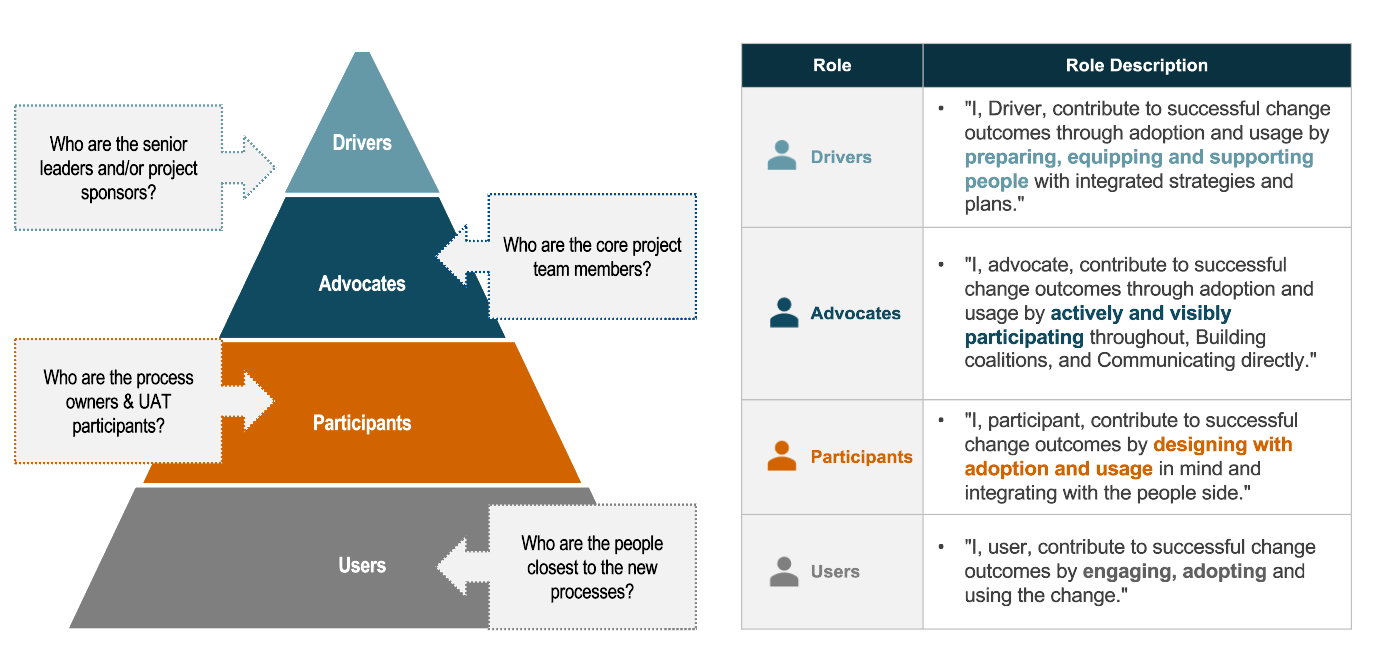Change management is the difference between speed to market and years of rework. Large change initiatives have a way of surfacing poor project management habits, uncovering gray areas in existing reporting structures, and spotlighting inefficiencies that were once papered over.
To pull off lasting transformation, ultimate accountability is required. That means designing a successful change management model that defines roles and responsibilities articulately and effectively.
Once the framework is stood up, accountability is realized through proper execution.
Architecting the Change Management Team
Depending on precedents set by leaders, proposed change can elicit numerous responses from employees, ranging from a shoulder shrug or outright resistance to excitement or questions. It’s a mixed bag that’s often deeply embedded in organizational culture and something the organization should expect in advance.
To properly set expectations, enact a communication plan, and begin to execute a successful business transformation, a change model is needed.
Outlined below is a useful starting point for appointing stakeholders to the change management team and designing a change model that drives accountability:

Drivers
Change drivers are the leaders, partners, or sponsors with the authority to direct a transformation effort and support the business with the information, tools, and outcomes they need to be fully aligned with the initiative.
They provide clarity, vision, resources, and executive buy-in so that other members of the change management team can execute core tasks and remain on schedule and on brief. Depending on the type of transformation, this role is often suited for executives in key functional areas, like an HR leader or financial officer.
Advocates
Advocates are the change agents who build coalitions around ideas, energize the transformation with their enthusiasm, and provide key oversight on the day-to-day happenings of the project. An advocate is often a key director, change manager, or project manager who can help define the future-state business process.
Participants
Participants execute and own the processes and tasks of the project. They are designing the software, implementing the system, or building the transformation framework for the rest of the business to ultimately use.
Participants are translating leadership’s vision into concrete progress and ensuring end users will be satisfied with the outcome of the change project and that all iterating and testing have been completed prior to rollout. Participants are also instrumental in developing a training program, educational guides, and supporting materials for users after launch.
Users
Users are those most impacted by the change. If a policy update or new tool affects their team’s workflows, job expectations, or job satisfaction, their input and viewpoints must be respected and understood. Their feedback is critical at multiple stages of the change management process, as adoption effectively rests with them.
Accountability Where It Counts
Accountability must permeate all levels of the business in two ways: structurally and personally.
Structural Accountability
If the right governance model, progress reporting, and reinforcement activities are not established in advance of significant change, what results is lackluster adoption, resistance, and question marks.
Structurally, the business did put the necessary systems and processes in place to ensure a successful change. The change leader was unaccountable to staff. In this scenario, the benefits of agile change management may be useful, as the agile framework already contains the structure and processes to overcome accountability issues.
Personal Accountability
Personal accountability also matters. From the most-tenured employee to the newest direct report on the team, staff should feel empowered to voice their feedback early on. Withholding critical feedback during the change effort could result in a key change request going unheard – one that may be vital to future employee satisfaction. Employees are accountable to the business via the change management strategy.
Communication is a two-way street. Whether it’s human resources, the lead change practitioner, or some form of change advisory board, leadership is tasked with appropriately communicating the change initiative downward and laterally throughout the business. This means communication should come often and through a variety of mediums. Employees are tasked with offering on-the-ground insights and strategic change requests upward.
Together the change process can be made more efficient, transparent, effective, and … accountable.
For expert change management support during your transformation, contact CrossCountry Consulting.